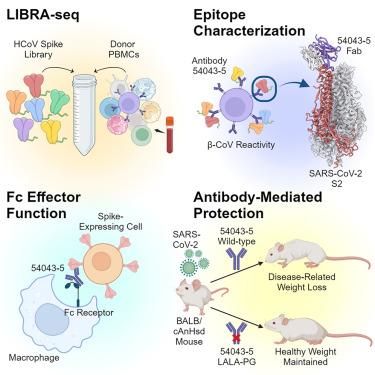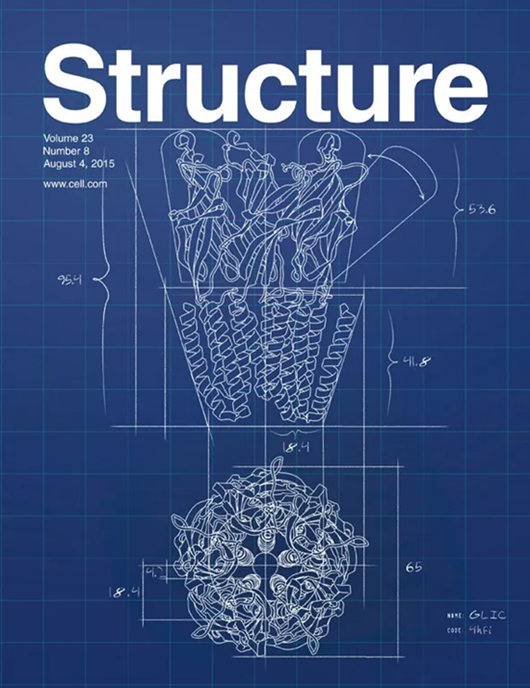Discovery and characterization of a pan-betacoronavirus S2-binding antibody
IF 4.4
2区 生物学
Q2 BIOCHEMISTRY & MOLECULAR BIOLOGY
引用次数: 0
Abstract
The continued emergence of deadly human coronaviruses from animal reservoirs highlights the need for pan-coronavirus interventions for effective pandemic preparedness. Here, using linking B cell receptor to antigen specificity through sequencing (LIBRA-seq), we report a panel of 50 coronavirus antibodies isolated from human B cells. Of these, 54043-5 was shown to bind the S2 subunit of spike proteins from alpha-, beta-, and deltacoronaviruses. A cryoelectron microscopy (cryo-EM) structure of 54043-5 bound to the prefusion S2 subunit of the severe acute respiratory syndrome coronavirus 2 (SARS-CoV-2) spike defined an epitope at the apex of S2 that is highly conserved among betacoronaviruses. Although non-neutralizing, 54043-5 induced Fc-dependent antiviral responses in vitro, including antibody-dependent cellular cytotoxicity (ADCC) and antibody-dependent cellular phagocytosis (ADCP). In murine SARS-CoV-2 challenge studies, protection against disease was observed after introduction of Leu234Ala, Leu235Ala, and Pro329Gly (LALA-PG) substitutions in the Fc region of 54043-5. Together, these data provide new insights into the protective mechanisms of non-neutralizing antibodies and define a broadly conserved epitope within the S2 subunit.

发现泛胸腺病毒 S2 结合抗体并确定其特性
致命的人类冠状病毒不断从动物病毒库中出现,这凸显了为有效防范大流行而采取泛冠状病毒干预措施的必要性。在这里,我们通过测序(LIBRA-seq)将 B 细胞受体与抗原特异性联系起来,报告了从人类 B 细胞中分离出的 50 种冠状病毒抗体。其中,54043-5 被证明能与α-、β- 和 deltacoronaviruses 的尖峰蛋白 S2 亚基结合。54043-5 与严重急性呼吸系统综合征冠状病毒 2(SARS-CoV-2)尖峰的预融合 S2 亚基结合的冷冻电镜(cryo-EM)结构确定了 S2 顶点的表位,该表位在 betacoronaviruses 中高度保守。虽然 54043-5 不具有中和作用,但它能在体外诱导 Fc 依赖性抗病毒反应,包括抗体依赖性细胞毒性(ADCC)和抗体依赖性细胞吞噬作用(ADCP)。在小鼠 SARS-CoV-2 挑战研究中,在 54043-5 的 Fc 区引入 Leu234Ala、Leu235Ala 和 Pro329Gly(LALA-PG)替代后,可观察到对疾病的保护作用。总之,这些数据为非中和抗体的保护机制提供了新的见解,并确定了 S2 亚基中一个广泛保守的表位。
本文章由计算机程序翻译,如有差异,请以英文原文为准。
求助全文
约1分钟内获得全文
求助全文
来源期刊

Structure
生物-生化与分子生物学
CiteScore
8.90
自引率
1.80%
发文量
155
审稿时长
3-8 weeks
期刊介绍:
Structure aims to publish papers of exceptional interest in the field of structural biology. The journal strives to be essential reading for structural biologists, as well as biologists and biochemists that are interested in macromolecular structure and function. Structure strongly encourages the submission of manuscripts that present structural and molecular insights into biological function and mechanism. Other reports that address fundamental questions in structural biology, such as structure-based examinations of protein evolution, folding, and/or design, will also be considered. We will consider the application of any method, experimental or computational, at high or low resolution, to conduct structural investigations, as long as the method is appropriate for the biological, functional, and mechanistic question(s) being addressed. Likewise, reports describing single-molecule analysis of biological mechanisms are welcome.
In general, the editors encourage submission of experimental structural studies that are enriched by an analysis of structure-activity relationships and will not consider studies that solely report structural information unless the structure or analysis is of exceptional and broad interest. Studies reporting only homology models, de novo models, or molecular dynamics simulations are also discouraged unless the models are informed by or validated by novel experimental data; rationalization of a large body of existing experimental evidence and making testable predictions based on a model or simulation is often not considered sufficient.
 求助内容:
求助内容: 应助结果提醒方式:
应助结果提醒方式:


